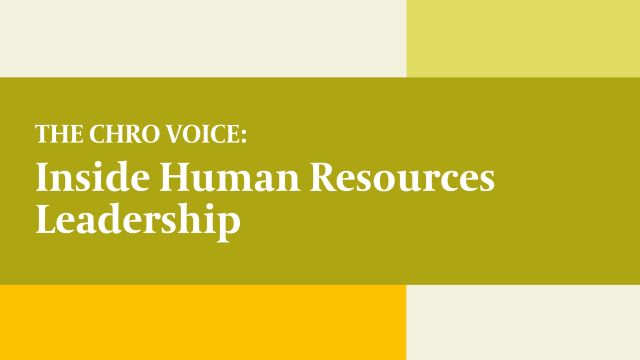Companies need more than just recruitment and talent development plans; they need improved access and quality in healthcare while reducing claim costs, compensation programs that incent the right behaviors and achieve the right results, and culture initiatives that make the company an employer of choice.
 Mark GriffinCHRO of BJ’s Wholesale Club
Mark GriffinCHRO of BJ’s Wholesale Club
As the CHRO role becomes more closely integrated with the development of long-term business strategy, HR leaders today must begin to rethink their criteria for recruiting and assessing the talent and performance of C-Suite executives.
We sat down with Mark Griffin, CHRO of BJ’s Wholesale Club, who shared key insights gained from his experience with large, frontline workforces and what he’s learned about the importance of bold, honest conversations to ensure organizations not only perform well today but are also prepared to grow and thrive into the future.
What are your thoughts on the current evolution of the CHRO role, and why do you think it’s become one of the fastest growing positions in the C-Suite?
It’s a fast-growing role for a variety of reasons, a lot of which come down to significant changes and events happening in society. Primarily, what’s going on in the industry is that the human capital landscape is continuously becoming more complex. There were the impacts of the pandemic, of course, and now with a new U.S. administration coming in, you have a whole new set of changes that companies are trying to deal with. And because a lot of these changes will end up impacting people, HR expertise and perspective is needed now more than ever and at the highest levels of the business.
Other factors like ESG programs, labor costs, and rising healthcare expenses also play a role. The Chief HR Officer's role is increasingly influential in business, and the pace of change is driving this shift. It all has impact on human capital, which is why companies are turning to Chief HR Officers. Companies need more than just recruitment and talent development plans; they need improved access and quality in healthcare while reducing claim costs, compensation programs that incent the right behaviors and achieve the right results, and culture initiatives that make the company an employer of choice. Key business drivers also have significant financial impacts, making it crucial for CEOs and CFOs to rely on their Chief HR Officers.
With the pace and change of the role, are you focusing more heavily on any particular areas?
Healthcare comes to mind when it comes to reaching our team members and giving them access to quality care at an affordable price. We saw employees who were eligible for healthcare not enrolling because of cost concerns. Our goal was to make healthcare more affordable, so our team members could pay for the right coverage while not having to increase the company’s cost share. There are different ways to achieve this, such as working with various healthcare partners to share the costs. For example, we're partnering with a company called Transcarent, which is very cutting edge in this space. Even our HR technology platform, Workday, is innovative with their use of electronic agents. Imagine our team members, most of whom are frontline retail workers, using their iPhone to access their data in the HR system without having to navigate through multiple drop-down menus, while getting their questions answered via chat or voice and receive answers from an electronic agent.
Another area is executive compensation, which continues to grow, and with boards of directors keen on driving growth, there's a push for innovative incentive plans to motivate employees to think outside the box.
Lastly, the competition for talent has always been fierce, but it reached new heights during COVID, even for hourly positions like cashier positions. Although things have improved, there's still a strong competition for top talent in areas like marketing, merchandising, finance, and strategy. The pool of experienced talent has shrunk, making it essential for companies to be employers of choice to attract and retain the best talent.
The pool of experienced talent has shrunk, making it essential for companies to be employers of choice to attract and retain the best talent.
Mark GriffinCHRO of BJ’s Wholesale Club
How is BJ’s thinking about what, where and how work looks like today and in the immediate future?
We've learned a lot through COVID. Our stores and distribution centers stayed open through the pandemic. Our headquarters, which we call our club support center, closed during that period and people worked from home. We found that we could do both effectively. Now, we are three days in the office and two remote. We believe that we work better when we're together. When you have an opportunity to work side by side with people face to face, being able to drop in and check in on something, making a personal connection is way more powerful and better than having to work remotely.
From a Chief HR Officer perspective, you want to make sure that your people don't think to themselves, "I did exactly what I do at home while at the office." Whatever it is, you have to change the schedule of work so when people are in, they're doing work that's valuable to do together – and they know it. You want people to experience at least one thing every day that makes them say, "it made a difference being in the office today." I think that's part of the Chief HR Officer's role to help influence that environment.
You have a lot of experience working as a CHRO, particularly in the context of CEO and C-Suite level succession. What role have you played and how are you thinking about it in today’s landscape?
It’s a partnership role, primarily between the CHRO, the CEO, and the board. And yes, their main objective out of the gate is the succession plan for the CEO role, but they also want to make sure you have other plans in place and enough bench strength distributed throughout the rest of the top team. In my organization, we meet every year in the fall, and I go over a talent development plan, which takes the board through the whole talent ecosystem, from our frontline retail workers to our top executives. Who do we have in place? What roles would we modify if someone left? How would we backfill key positions if we needed to?
The board is also more involved in understanding the organizational structure, and how we rotate some of our executives to keep them motivated when they have different skills. This is where I think the CHRO really needs to be driving the conversation and strategy because a big part of the role is being able to speak frankly and honestly about talent assessment at the executive level.
It’s a partnership role, primarily between the CHRO, the CEO, and the board. And yes, their main objective out of the gate is the succession plan for the CEO role, but they also want to make sure you have other plans in place and enough bench strength distributed throughout the rest of the top team.
Mark GriffinCHRO of BJ’s Wholesale Club
There’s a big difference in the assessment process when you’re talking about the C-Suite. They’re all great at what they do and wouldn’t be there if they weren’t. So, in many cases it isn’t a question of performance but rather “Is this the right person with the right skills to take us forward? Will they propel us into the future in a way that aligns with our growth plans? Will they be able to adapt to new technology and industry headwinds? Are they creative enough to come up with new ideas that put the company on a new path?” I think that’s really the hardest part - being able to assess for future impact on the company as opposed to how they performed last year against their goals.
That's really the trick, and if you’re good at that, then I think you’re adding real value as a CHRO. And it does require being as bold and honest as possible, because it isn’t easy to say, “Well, we love this person, they do a great job at XYZ, but they aren’t what we need for the future.” That’s a really tough thing to do, and you also have to be right about it because there’s so much at stake.
How have you seen yourself learn and grow as an HR leader over the years, and how do you use what you’ve learned to evolve and prepare for the future?
I’ve been able to learn the most by reflecting on questions in the past that I haven’t been able to answer well. There’s a lot of feedback you get from your peers, the CEO, and the board, and if you don’t have a good answer for something and you’re scratching your head saying, “Oh boy, that’s a great question,” then that’s something you need to figure out how to have an answer for going forward. I’ve learned a lot by not having a good answer to certain questions, and now I work hard to make sure I have processes in place, and that I’m prepared for as much as possible, and continuing to build my own skill set.
Another lesson you learn after being a CHRO and drafting talent for a long time is that it’s possible for a top leader who you never expect to fail, end up failing as the company grows because they don’t have what it takes to keep up with advancements. And then you have to ask, “Hey, this person used to be one of our top executives, so what happened?” And usually, the simple answer is they were really good at what the company used to do, but they didn’t have the skills needed to support this new path we are taking. Then you have to take another step back and ask why didn’t we see that? Why didn’t we get ahead of that talent gap and react before it impacted the company?
So, it’s really a combination of learning from the questions you can’t answer, as well as those times you were wrong about someone’s ability to bring value both today and in the future. And improving in these areas is crucial, because the CEO and the board are going to be worried about last quarter’s performance and guidance for the next, so it’s up to the CHRO to take a step back and push those issues that may not seem relevant to day-to-day operations. It’s about pushing them to assess the top team in terms of their ability not just to perform well today, but to get us where we need to be in three to five years.











